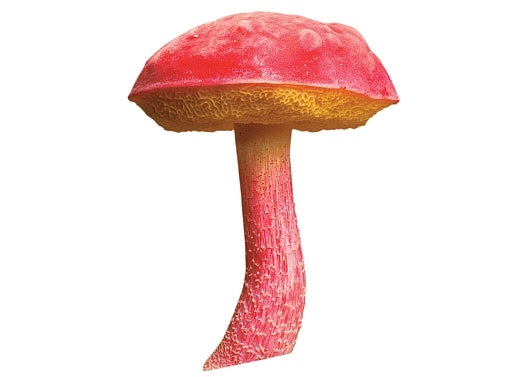The new Book of Fungi, by Peter Roberts and Shelley Evans, is a couple of kilograms worth of beautiful mushroom book. The lurid photographs and enticing, offhandedly witty descriptions make the reader want to go out collecting specimens right away — but the hardcover book’s glaring flaw is that, with actual-size glossy pictures of 600 species of fungus, it’s hardly a portable companion to the wonders of the woods.
Click here to see a few of our favorites.
So instead it sits on the desk, where we alternately admire the images (a gallery of which we’ve pulled together here for your enjoyment); marvel at the collected facts (some fungi use microscopic lassos to rope in worms to eat!); and titter at species names like Drumstick Truffle-Club, Mousepee Pinkgill, and The Sickener.
For each species, the book gives an interesting description, including geographical distribution, habitat, edibility, on a scale from edible to unpleasant to poisonous, and other relevant facts. “In the past,” we learn, the Woolly Milkcap “was said to have been commonly roasted and added to coffee in Norway, though it is not clear why.”
Shaggy Inkcap
Young Shaggy Inkcaps can be eaten, but as these fungi grow older, they produce a black liquid, which used to be used as ink. The Shaggy Inkcap is also known as the Lawyer’s Wig.
Golden Scruffy
The Golden Scruffy mystified experts repeatedly, landing in 10 different genera before molecular research ended the arguments: it’s a Cyptotrama! The mushroom is at home in the tropics and some cooler climate woods. I think it looks like a Baked Alaska.
The Deceiver
The Deceiver made our list in large part due to its terrific name. The fungus is actually more mischievous than wicked. As the weather changes, so do the mushroom’s colors and textures, making it tough to identify. Its gills always remain the same hue, however, which gives the game away.
Pixie’s Parasol
Like everything else in Australia, except possibly sheep, this charmingly named mushroom is poisonous. The mushroom also makes its home in southern South America and New Zealand, hearkening back to a time before the continents completely split.
Golden Scalycap
The Chinese and Russians seem to cook some Golden Scalycap recipes, but there are reports that the fungi can poison “susceptible individuals.” Since these slimy mushrooms can make a living tree trunk rot, it might be best to just steer clear.
Zeller’s Bolete
Found in western North America into Central America, the Zeller’s Bolete has divided chefs. Some find it mucilaginous and tasteless while others devour it with great pleasure, and indeed grow it commercially in western Canada for the purpose. There is no debate on its appearance, however. The fungus is jauntily attired.
Devil’s Tooth
Oozing a dark red liquid from between tooth-like spines, the Devil’s Tooth seems to have come right out of a horror movie.* But the Devil’s Tooth actually has significant medicinal qualities and can be used to make green, gray and brown dyes. * Some less bloody-minded people think it looks like a delicious blueberry muffin.
Starfish Fungus
The Starfish Fungus trickles a malodorous slime from its central disk to attract flies, who then help disperse its spores. The fungus is harmless at its earliest stage, but when fully grown, the fungus is neither edible nor appetizing.
Woolly Bird’s Nest
Several times smaller than a real nest, the Woolly Bird’s Nest shelters its “eggs”, or small packets full of spores, in gooey liquid. Rain washes away the goo, and sends the eggs away from the nest where the moist conditions are perfect for spore germination.








